
Naive Art -I
Outsider art
Naïve art
Naïve art is usually defined as visual art that is created by a person who lacks the formal education and training that a professional artist undergoes (in anatomy, art history, technique, perspective, ways of seeing). When this aesthetic is emulated by a trained artist, the result is sometimes called primitivism, pseudo-naïve art, or faux naïve art.
Unlike folk art, naïve art does not necessarily derive from a distinct popular cultural context or tradition; indeed, at least in the advanced economies and since the Printing Revolution, awareness of the local fine art tradition has been inescapable, as it diffused through popular prints and other media. Naïve artists are aware of "fine art" conventions such as graphical perspective and compositional conventions, but are unable to fully use them, or choose not to. By contrast, outsider art (art brut) denotes works from a similar context but which have only minimal contact with the mainstream art world.
Naïve art is recognized, and often imitated, for its childlike simplicity and frankness. Paintings of this kind typically have a flat rendering style with a rudimentary expression of perspective. One particularly influential painter of "naïve art" was Henri Rousseau (1844–1910), a French Post-Impressionist who was discovered by Pablo Picasso.
The definition of the term, and its "borders" with neighbouring terms such as folk art and outsider art, has been a matter of some controversy. Naïve art is a term usually used for the forms of fine art, such as paintings and sculptures, made by a self-taught artist, while objects with a practical use come under folk art. But this distinction has been disputed. Another term that may be used, especially of paintings and architecture, is "provincial", essentially used for work by artists who had received some conventional training, but whose work unintentionally falls short of metropolitan or court standards.
Outsider art (Art brut)
Outsider art is art made by self-taught individuals who are untrained and untutored in the traditional arts with typically little or no contact with the conventions of the art worlds.
The term outsider art was coined in 1972 as the title of a book by art critic Roger Cardinal. It is an English equivalent for art brut (French: [aʁ bʁyt], "raw art" or "rough art"), a label created in the 1940s by French artist Jean Dubuffet to describe art created outside the boundaries of official culture. Dubuffet focused particularly on art by those on the outside of the established art scene, using as examples psychiatric hospital patients, hermits, and spiritualists.
Outsider art has emerged as a successful art marketing category; an annual Outsider Art Fair has taken place in New York since 1993, and there are at least two regularly published journals dedicated to the subject. The term is sometimes applied as a marketing label for art created by people who are outside the mainstream "art world" or "art gallery system", regardless of their circumstances or the content of their work. A more specific term, "outsider music", was later adapted for musicians.
Grandma Moses
1860 – 1961

Anna Mary Robertson Moses
(September 7, 1860 – December 13, 1961), or Grandma Moses, was an American folk artist. She began painting in earnest at the age of 78 and is a prominent example of a newly successful art career at an advanced age. Moses gained popularity during the 1950s, having been featured on a cover of Time Magazine in 1953, was a subject of numerous television programs and of a 1950 Oscar-nominated biographical documentary. Her autobiography, titled My Life's History, was published in 1952. She was also awarded two honorary doctoral degrees.
Moses was a live-in housekeeper for a total of 15 years, starting at age 12. An employer noticed her appreciation for their prints made by Currier and Ives, and they supplied her with drawing materials. Moses and her husband began their married life in Virginia, where they worked on farms. In 1905, they returned to the Northeastern United States and settled in Eagle Bridge, New York. They had ten children, five of whom survived infancy. She embroidered pictures with yarn, until disabled by arthritis.
In her 1961 obituary, The New York Times said: "The simple realism, nostalgic atmosphere and luminous color with which Grandma Moses portrayed simple farm life and rural countryside won her a wide following. She was able to capture the excitement of winter's first snow, Thanksgiving preparations and the new, young green of oncoming spring... In person, Grandma Moses charmed wherever she went. A tiny, lively woman with mischievous gray eyes and a quick wit, she could be sharp-tongued with a sycophant and stern with an errant grandchild."
Moses' work has been a subject of numerous museum exhibitions worldwide and has been extensively merchandised, such as on greeting cards. In 2006, her 1943 painting titled Sugaring Off was sold at Christie's New York for US$1.2 million, setting an auction record for the artist.

Catching the Turkey
Grandma Moses
1940

Sugaring Off
Grandma Moses
1943

Checkered House
Grandma Moses
1943

Early Springtime on the Farm
Grandma Moses
1945
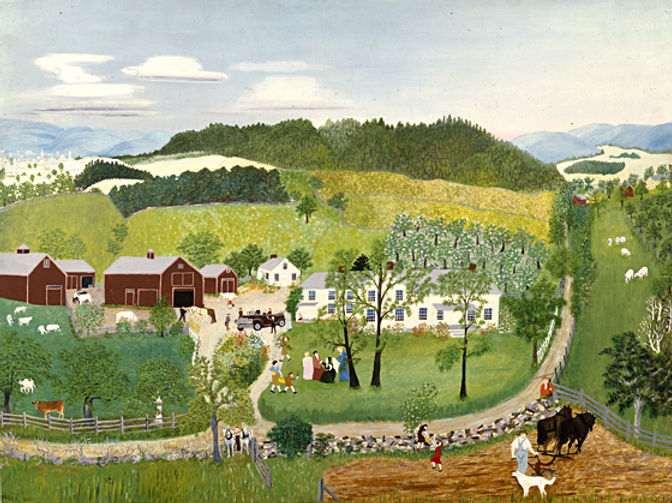
Grandma Moses
Goes to the Big City
1946

A Beautiful World
Grandma Moses
1948

Country Fair
Grandma Moses
1950

Checkered House
Grandma Moses

Christmas at Home
Grandma Moses

Waiting for Christmas
Grandma Moses
1960
Morris Hirshfield
1872 –1946
Morris Hirshfield
(1872–1946) was a Polish-American painter. He "is considered one of the most critically acclaimed self-taught artists of the 20th century" according to the J. Paul Getty Museum.
Hirshfield was born in Poland, but emigrated to the United States at the age of eighteen. He found employment at a women's coat factory; later, he founded a business with his brother, first manufacturing women's coats, then women's slippers. He retired in 1935 due to failing health.
Hirshfield began to paint in 1937. He was soon championed by gallerist Sidney Janis, who had a great interest in self-taught artists. Janis included some of Hirshfield's works in a 1939 exhibition, Contemporary Unknown American Painters, and a 1942 book, They Taught Themselves: American Primitive Painters of the 20th Century. His painting found favor in surrealist circles; he was lauded by André Breton, and was a participant in the first American surrealist exhibition, First Papers of Surrealism, in 1942.
He received a one-man show at the Museum of Modern Art in 1943. The show occasioned some negative criticism; Art Digest referred to Hirshfield as "The Master of Two Left Feet", and the bad press the show received figured into the demotion of MoMA's director, Alfred H. Barr Jr.
Hirshfield died in New York City in 1946.
Only 77 works were created by Hirschfield during his career. His heavily patterned work, featuring women or animals, is often reminiscent of textiles, perhaps as a legacy of his first career.

Morris Hirshfield, Cover of View magazine, October 1945.

Morris Hirshfield, The Artist and His Model, 1945

Morris Hirshfield, Tiger, 1940
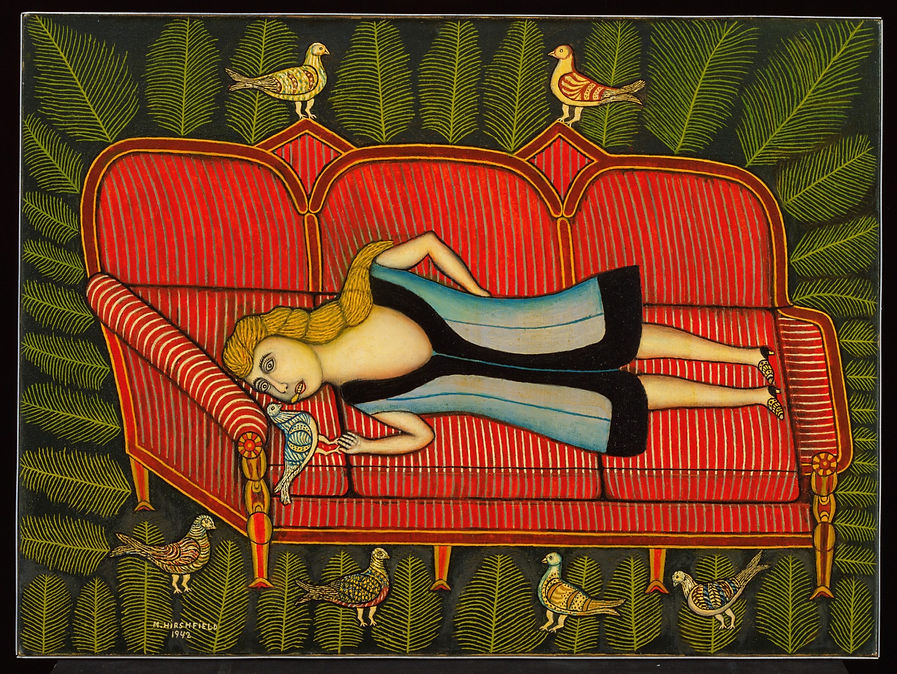
Morris Hirshfield, Girl with Pigeons, 1942

Morris Hirshfield, Stage Beauties, 1944
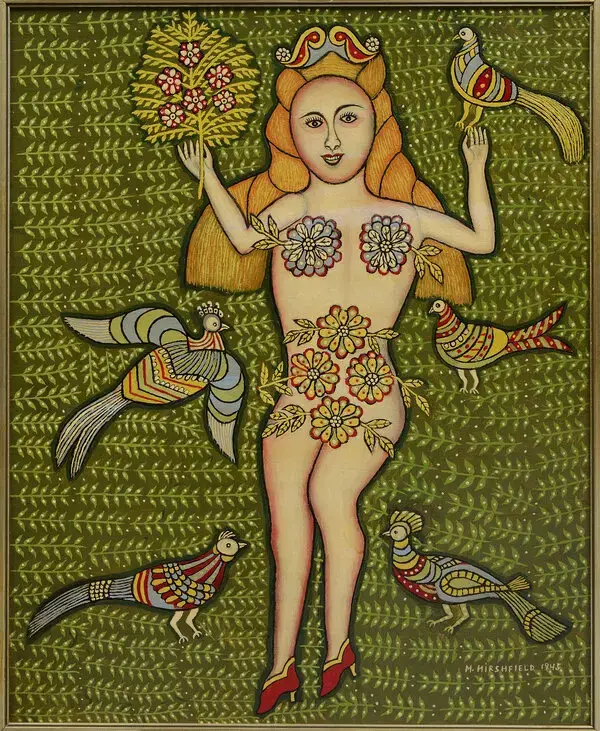
Morris Hirshfield, Girl with Pigeons

Morris Hirshfield, STAGE GIRLS WITH ANGELS, 1945

Morris Hirshfield, ÖL AUF LEINWAND

Morris Hirshfield, WOMAN AND DOG, 1945

Morris Hirshfield, Girl with Dog

Morris Hirshfield, Girl with Dog, 1943

CATS IN THE SNOW , 1946
Morris Hirshfield
Augustin Lesage
1876 – 1954
Augustin Lesag
Augustin Lesage (1876 – 1954) was a French coal miner who later became an artist, following the direction of a voice he heard. As an artist, he was untrained and is thus considered an outsider artist or as part of the art brut movement (another term for outsider art). The French artist Jean Dubuffet coined the term art brut (French for ‘raw art’), which he characterised as:
Those works created from solitude and from pure and authentic creative impulses – where the worries of competition, acclaim and social promotion do not interfere – are, because of these very facts, more precious than the productions of professionals. After a certain familiarity with these flourishings of an exalted feverishness, lived so fully and so intensely by their authors, we cannot avoid the feeling that in relation to these works, cultural art in its entirety appears to be the game of a futile society, a fallacious parade.
This certainly typifies the kind of artwork produced by Lesage. He was a non-professional, self-taught, had no contact with the mainstream art world or institutions, and his art comes from raw creative impulses (voices he had heard, which he believed belonged to the spirit world). Like many other outsider artists, Lesage’s artwork was inspired by unusual mental states.
His artistic journey began at the age of 35 when, while working in the mine, he heard a voice tell him that he would become an artist. Lesage believed the voice he heard was that of his deceased younger sister, who died at the age of three. She instructed him on what to paint and what materials to use. The voices he heard from the spirit world – including the voice of his sister – would inspire his various drawings and paintings. Lesage once stated:
In January 1912, powerful spirits came and revealed themselves to me, ordering me to draw and paint, something which I had never done before. […] ‘Do not worry about insignificant details,’ was their response. ‘We are the ones working through your hands.’
As well as creating art based on the direction of these spirit voices, Lesage acted as a medium in séances, summoning and communicating with spirits. He is a mediumistic or spiritualist artist, so he draws on the spiritualist belief that the spirits of the dead – who exist in an independent spirit world – communicate with the living.
Lesage was extremely prolific as an artist, producing around 800 paintings. And the pieces he created, with the guidance of the spirit voices he heard, are strange and unique. His paintings are highly intricate, symmetrical, colourful, and architectonic. His paintings are quite reminiscent of ancient Egyptian art, hieroglyphics, and architecture, as well as Oriental architectural forms.

Augustin Lesage

Augustin Lesage

Augustin Lesage

Augustin Lesage

Augustin Lesage

Augustin Lesage

Augustin Lesage

Augustin Lesage
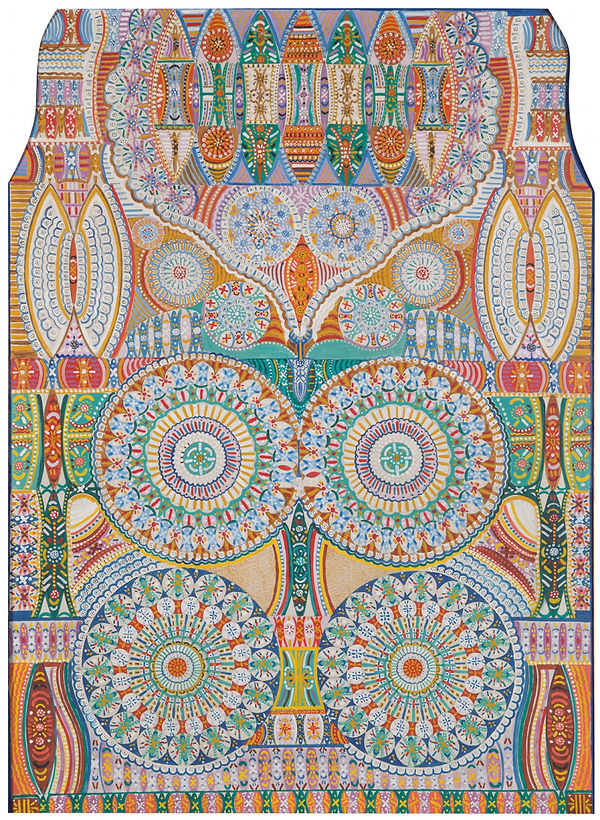
Augustin Lesage

Augustin Lesage
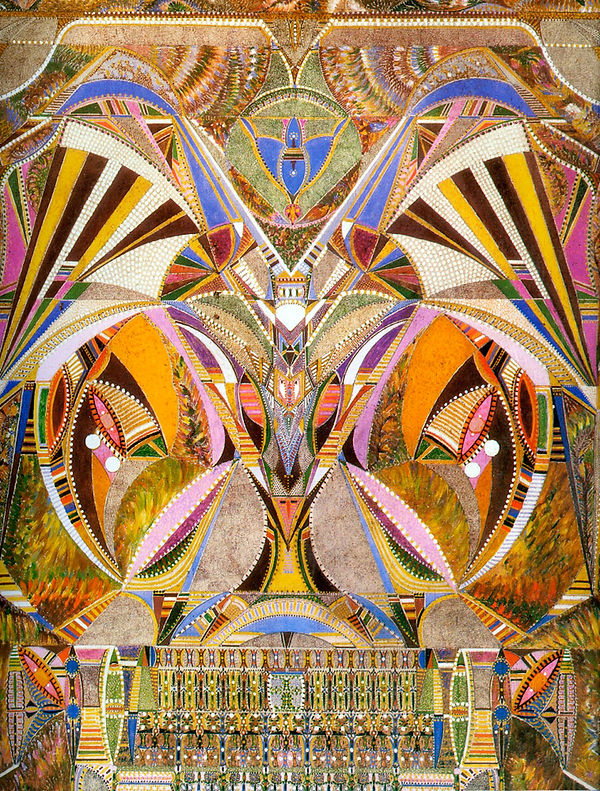
Augustin Lesage
Aloise Corbaz
1886 – 1964
Aloïse Blanche Corbaz
(28 June 1886 – 5 April 1964) was a Swiss outsider artist included in Jean Dubuffet's initial collection of psychiatric art. She is one of very few acclaimed female outsider artists.
Aloïse Blanche Corbaz was born in Lausanne, Switzerland in 1886. She earned her baccalauréat in 1906. Although she dreamt of becoming a singer, Aloïse worked as a dressmaker until leaving for Germany in 1911. She eventually found work as a teacher and a governess, in Potsdam, at the court of German Kaiser Wilhelm II. While there, she developed an obsessive romantic passion for the Kaiser. The start of World War I necessitated Aloïse's return to Switzerland. Her imaginary romance with the Kaiser continued, leading to her being diagnosed with schizophrenia and committed to the asylum at Cery-sur-Lausanne in 1918. In 1920 she was moved to an annex of the hospital, la Rosiere a Gimel, where she remained until her death in 1964.

Aloïse Corbaz

Aloïse Corbaz

Aloïse Corbaz

Aloïse Corbaz

Aloïse Corbaz

Aloïse Corbaz

Aloïse Corbaz
Camille Bombois
1883 – 1970

CAMILLE BOMBOIS

Camille Bombois
(3 February 1883 – 6 June 1970) was a French naïve painter especially noted for paintings of circus scenes.
Bombois was born in Venarey-les-Laumes in the Côte-d'Or, in humble circumstances. His childhood was spent living on a barge and attending a local school until the age of twelve, when he became a farm worker. During his free time he drew and competed in wrestling competitions at local fairs. He became a champion local wrestler before joining a traveling circus as a strongman and wrestler.
In 1907, Bombois fulfilled his dream of moving to Paris, where he married and worked as a railway laborer, eventually finding a night job at a newspaper printing plant handling heavy newsprint rolls. Despite the exhausting nature of his job he painted from dawn to dusk, sleeping little. He showed his paintings in sidewalk exhibitions, but his earliest paintings, revealing the influence of the old masters in their subdued use of color, attracted few buyers.
1914 marked the beginning of four-and-a-half years of military service in World War I. Bombois spent much of it on the front line, earning three decorations for bravery. Upon his return home, encouraged that his wife had succeeded in selling a number of his paintings in his absence, he resumed his routine of night labor and daytime painting. In 1922, his sidewalk displays in Montmartre began attracting the attention of collectors. The art dealer Wilhelm Uhde "discovered" him in 1924, and exhibited Bombois' work in the Galeries des Quatre Chemins in 1927. In 1937, his works were shown in the exhibition "Maîtres populaires de la réalité" in Paris. His first solo show was in 1944 at the Galerie Pétridès. Critics compared Bombois' work to that of Henri Rousseau, which it resembled in its naïve drawing, crisp delineation of form, and attention to detail, although Bombois was less of a fantasist than Rousseau.
The paintings of his maturity are bold in color, featuring strong contrasts of black, bright reds, blues and electric pinks. Drawing from his own experiences, he often painted circus performers and landscapes with fishermen. His paintings of women are emphatic in their carnality, and his landscapes are notable in their careful attention to space, and to the effects of reflected light on water. Bombois' works are on view in many public collections, notably the Musée Maillol in Paris.

CAMILLE BOMBOIS

CAMILLE BOMBOIS

CAMILLE BOMBOIS

CAMILLE BOMBOIS

CAMILLE BOMBOIS
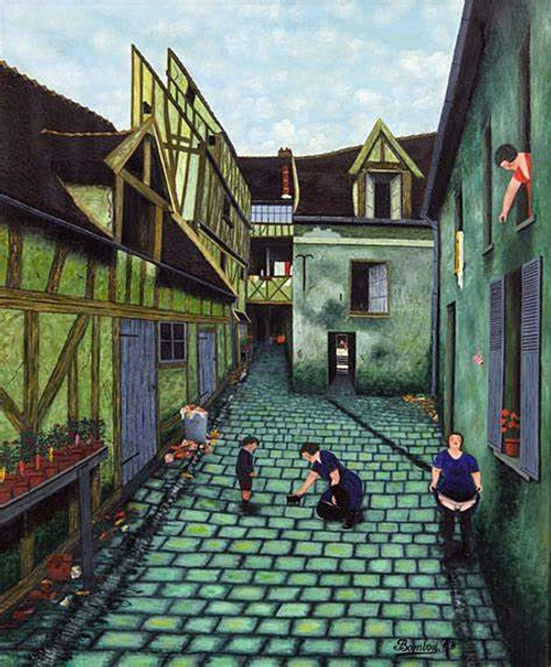
CAMILLE BOMBOIS

CAMILLE BOMBOIS

CAMILLE BOMBOIS

CAMILLE BOMBOIS
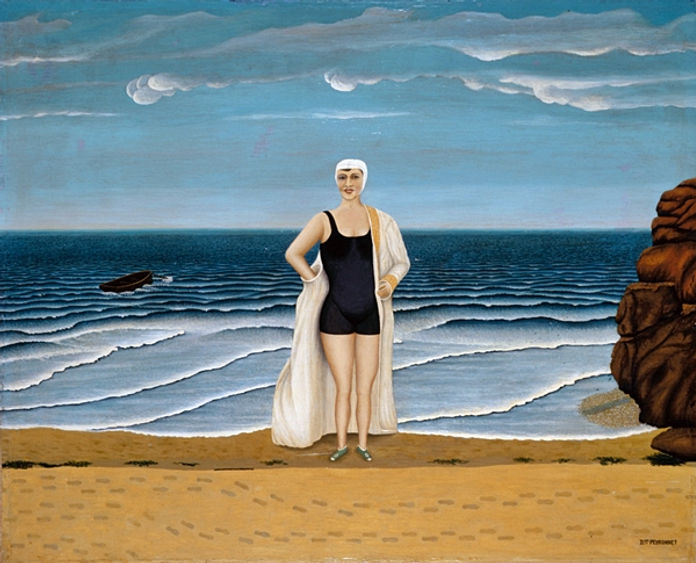
CAMILLE BOMBOIS

CAMILLE BOMBOIS

CAMILLE BOMBOIS
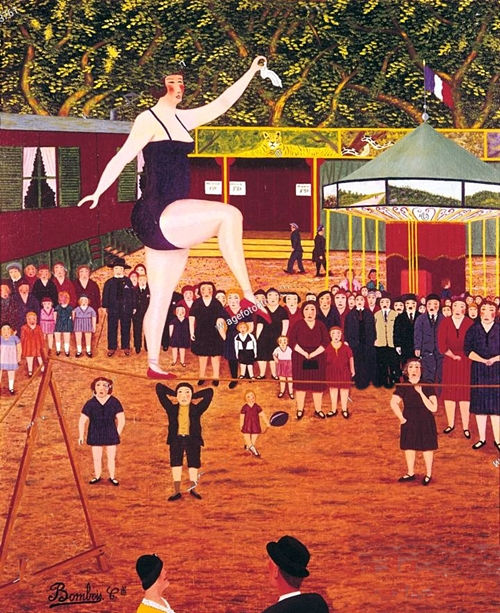
CAMILLE BOMBOIS

CAMILLE BOMBOIS

CAMILLE BOMBOIS

CAMILLE BOMBOIS

CAMILLE BOMBOIS

CAMILLE BOMBOIS

CAMILLE BOMBOIS

CAMILLE BOMBOIS
Tarsila do Amaral
1886 – 1973

Tarsila do Amaral
Tarsila de Aguiar do Amaral (1 September 1886 – 17 January 1973) was a Brazilian painter, draftswoman, and translator. She is considered one of the leading Latin American modernist artists, and is regarded as the painter who best achieved Brazilian aspirations for nationalistic expression in a modern style. As a member of the Grupo dos Cinco, Tarsila is also considered a major influence in the modern art movement in Brazil, alongside Anita Malfatti, Menotti Del Picchia, Mário de Andrade, and Oswald de Andrade. She was instrumental in the formation of the aesthetic movement, Antropofagia (1928–1929); in fact, Tarsila was the one with her celebrated painting, Abaporu, who inspired Oswald de Andrade's famous Manifesto Antropófago.

Tarsila do Amaral. Self-Portrait

"A Lua", Tarsila do Amaral
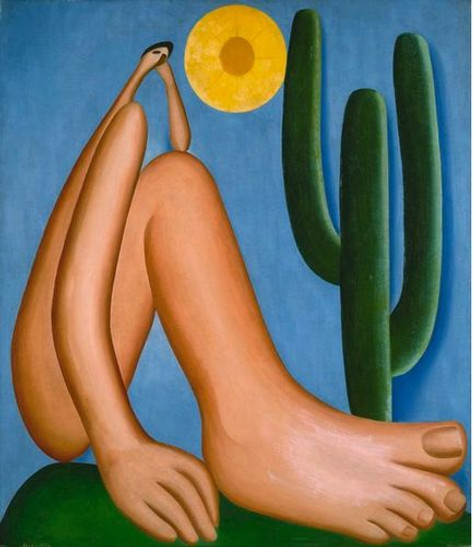
Tarsila do Amaral - Abaporu

Tarsila do Amaral - Carnival in Madureira (Carnaval em Madureira)

Tarsila do Amaral: Quem foi, obras e principais fases artísticas

Tarsila do Amaral - Pau Brasil

Tarsila do Amaral – A Negra

Tarsila do Amaral – Morro da Favela

Tarsila do Amaral. Antropofagia.

Tarsila do Amaral ‘Setting Sun’
Ovartaci
1894 – 1985
Ovartaci
Ovartaci was the artistic name of the Danish visual artist Louis Marcussen (1894 – 1985). In 1923, Ovartaci emigrated to Argentina for six years for work, along the way rambling and experimenting with drugs. Ovartaci was committed to the Risskov psychiatric hospital in 1929. She then had a sex change operation in 1957. She lived and worked in the institution for fifty-six years. In 1972 Ovartaci decided not to identify as a woman and started identifying as a man until his death in 1985.
Ovartaci's phantasmagoric work features numerous female and animal figures set within an abundance of symbols, interiors, and landscapes. These figures are invested with a sense of identification that seems to defy the divide between real life and the realm of art. In 2018 an expansive exhibition entitled "Ovartaci and the Art of Madness" included a survey of the artist's work, as well as homages and related works by contemporary artists. His art can be seen at Museum Ovartaci in Aarhus, Denmark, a museum named after him showcasing artwork created at the psychiatric hospital in Risskov, Denmark.

Ovartaci
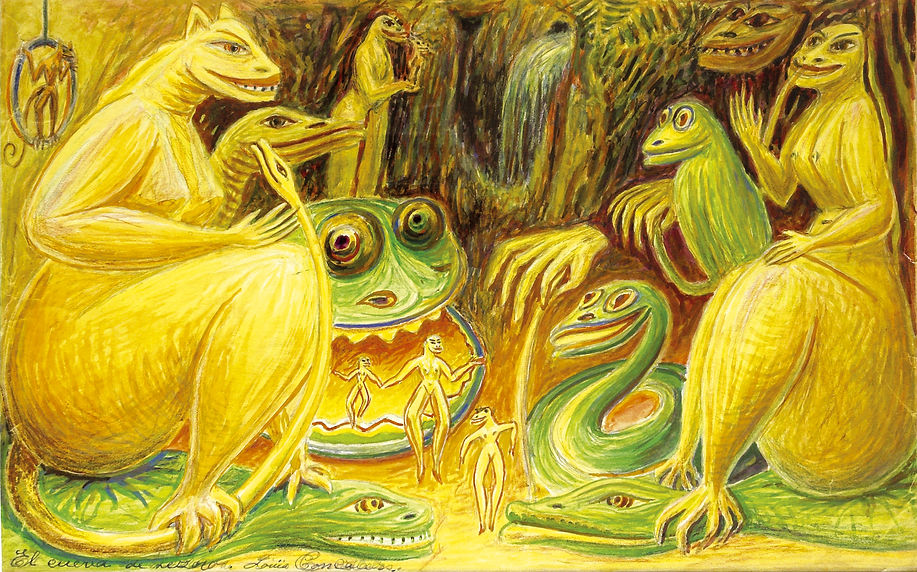
Ovartaci

Ovartaci

Ovartaci

Ovartaci

Ovartaci

Ovartaci

Ovartaci
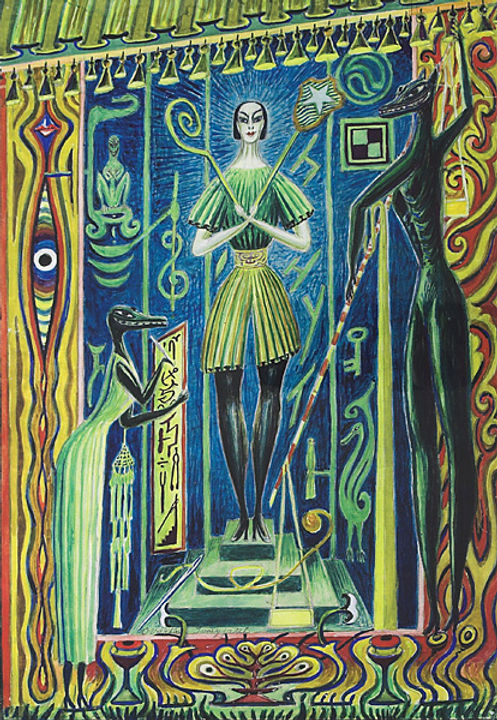
Ovartaci

Ovartaci
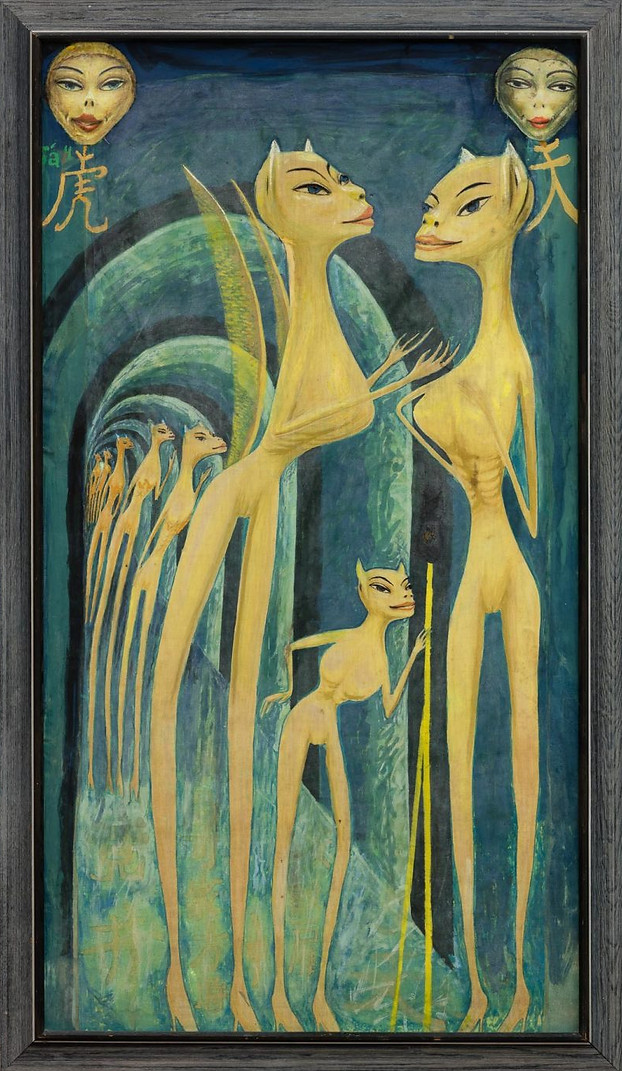
Ovartaci

Ovartaci

Ovartaci

Ovartaci

Ovartaci

Ovartaci